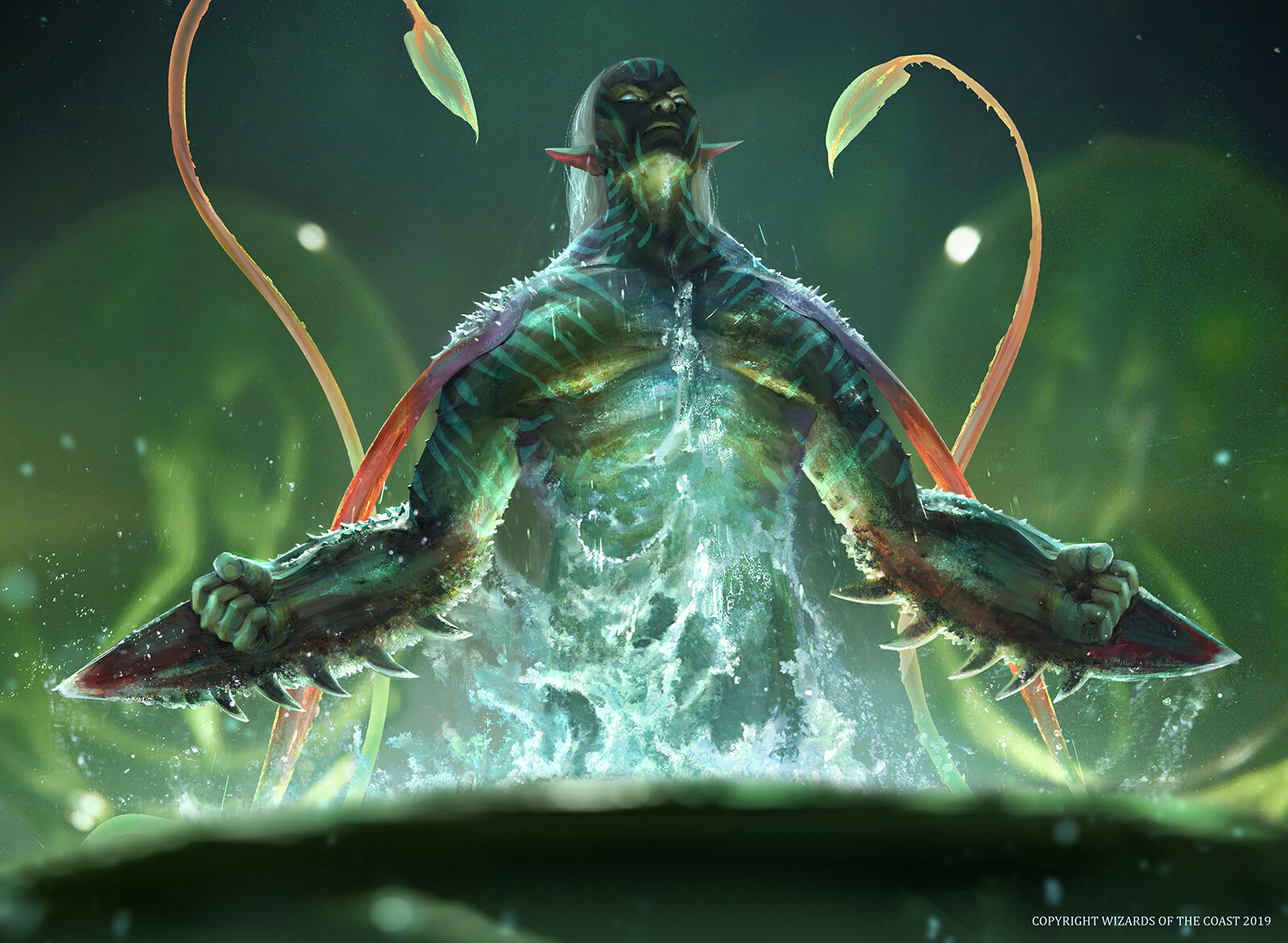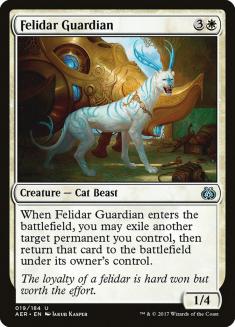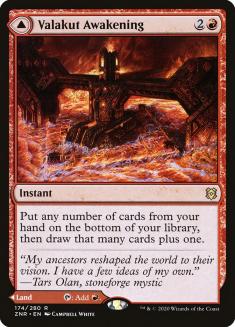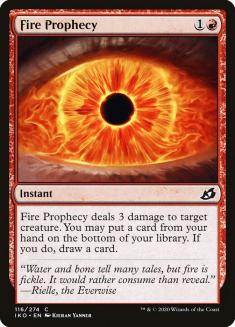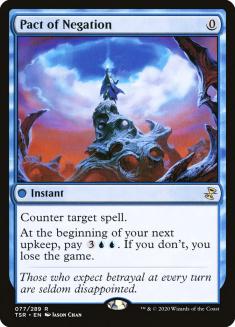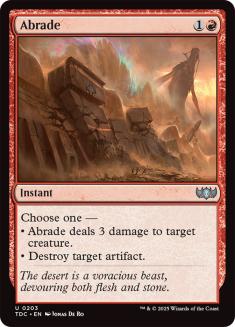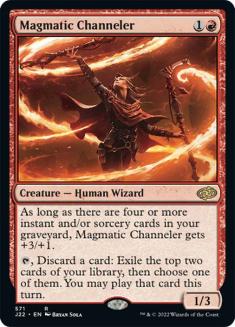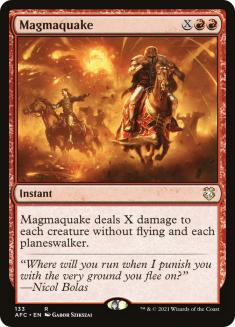With Omnath, Locus of Creation still running rampant in Zendikar Rising Standard and the Gruul Aggro deck being my current pet project in Pioneer (and I wrote about it already last week), I decided to delve a bit and find something a bit more…off the beaten path. Let’s just say that today’s deck spotlight will feature a color combination and archetype I’m intimately familiar with.
Throughout my tenure in Magic, Temur has always been something of a fascination. The core of each color shone through in all aspects. The red spells were utility, acting as a way to clear opposing creatures or provide the wielder with closing speed via burn. Green was the creature department. Big baddies from all across the multiverse could be seen roaming my spellbook’s pages. And blue? That was all the fun stuff. Cryptic Command and Remand and Jace, the Mind Sculptor. Blue meant possibility and flexibility. It was always the best because it was the most versatile, the least defined.
My favorite deck for a very long time was Temur Twin, a deck anyone who plays Modern should know to fear. Splinter Twin has long been one of the format’s boogiemen, banned for being too good at suppressing the format’s untamed strategies. Hexproof was a nightmare, but Splinter Twin could keep it in check.
The true strength of any Splinter Twin deck came from the fear of the combo rather than the combo itself. That’s something people became smarter about the second time around:
Once people realized you could use both halves of the combo to generate card advantage and battlefield advantage, the deck became something else entirely. The quest to make infinite Felidar Guardians was always the finish line, but the heart of the deck lay in the journey. Blinking Oath of Nissa with Felidar Guardian was delightful. Generating energy with Rogue Refiner to fuel Harnessed Lightning or Whirler Virtuoso was a treat. All the different parts and pieces just worked together perfectly, and I think we may have found the next Historic deck to repeat this process.
Folks, let me introduce you to Historic’s Temur Twin:
Creatures (26)
- 4 Llanowar Elves
- 4 Dualcaster Mage
- 1 Combat Celebrant
- 4 Gilded Goose
- 4 Tangled Florahedron
- 4 Sea Gate Stormcaller
- 4 Glasspool Mimic
- 1 Tuktuk Rubblefort
Lands (18)
Spells (16)
Sideboard

Llanowar Elves > Sea Gate Stormcaller > Neoform > Dualcaster Mage > Tuktuk Rubblefort
The combo might seem somewhat convoluted, but it really isn’t all that difficult. On the third turn, you can use Sea Gate Stormcaller to copy Neoform, which finds Dualcaster Mage, which copies Neoform, over and over again until you run out of clones and eventually find Tuktuk Rubblefort to give everything haste. It’s a little gimmicky, but the core of the deck is solid, and drawing some of the pieces on their own isn’t so bad. We also don’t have to “full combo” every time. It’s occasionally good enough to produce 30 power or so on the third turn.
The mana acceleration from Llanowar Elves and Gilded Goose gives us bursts of creatures or dig spells in the first few turns. They also double as bodies for Neoform to sacrifice for the combo while accelerating you to said combo one turn earlier than normal. In this way, the deck acts a lot like the old Jeff Hoogland favorite Kiki Chord. A creature-centric deck that has a combo kill is unusual in Magic, but it’s always a fun time when it comes around.
Valakut Awakening surprised me. I’ve tried all sorts of cards like this in the past, but rarely does one feel as good as Valakut Awakening does in this deck. With so many pieces of your deck dedicated to the combo, and not really need all of them in your deck at any given time, Valakut Awakening can often dig you toward your combo while shuffling away up to five or six dead cards from hand. The fact that it replaces itself is also a huge deal, as losing card economy against an attrition-based deck is a nightmare.
With Llanowar Elves and Gilded Goose, you can flood out quite often. However, the DFCs have helped tremendously in that regard and Valakut Awakening is just another solid part of that. I absolutely love all of them, but Valakut Awakening has just been phenomenal. I don’t know what else to say.
I’m not 100% on where the initial build came from, but I do know that Jeff Hoogland played something similar to this on stream a few days ago. This is my biggest “innovation” to an archetype built by someone else. The first time I ever cast Fire Prophecy, I “got” it. As someone who’s played See Beyond in Modern before to shuffle in extra combo pieces, Fire Prophecy is a dream come true. I’m just sad it hasn’t found a home until now.
Fire Prophecy is a sweet card, but it’s important to note just how good it is in this deck. When Valakut Awakening is stellar, Fire Prophecy can certainly be a juicy number. Removing an opposing creature buys you time, but it’s rare we get removal that doubles as card selection. Fire Prophecy is very cheap, which works nicely with one of the best cards in our deck: Sea Gate Stormcaller.
While we’re probably saving one Sea Gate Stormcaller for when we draw Neoform, using it to copy removal spells can buy us a ton of time against the creature-based decks in the format. And while it’s a bit more expensive, you can certainly do the same thing with an extra Dualcaster Mage from time to time, much like its initial intent.
Many versions of the deck play Pact of Negation, a spell I’m intimately familiar with. Throughout the past fifteen or so years, Pact of Negation has skirted the edges of “playable” and “broken,” but I’ve never personally loved it outside of a deck that can tutor for a singleton or uses it to kill the opponent via Hive Mind. On occasion, it works like a Force of Will when snagged via Cunning Wish.
It’s a counterspell that’s usually used to protect you from an opposing piece of interaction during your big combo turn. Outside of that one turn, it isn’t very good. As a protection piece against other counterspells, it’s quite strong, because there’s a good chance you’ll win the battle over the combo when your protection is free. I also think it was quite ridiculous in a ramp deck focused around resolving one big spell, like Hour of Promise during the era of Field of the Dead. Like Primeval Titan decks, you can usually resolve your game-breaking win condition and then still just pay for Pact of Negation on the following turn.
Pact of Negation can be used as a protection spell from an opposing combo, but that’s going to be rare. It’s an inefficient answer to most opposing strategies, as five mana is quite steep. The best way to utilize Pact of Negation is making sure you don’t actually have to pay the five mana on the next turn because your opponent is dead!
I like it in the sideboard here, as it shines against an opponent using Mystical Dispute or other counterspells as interaction. It sucks horribly against the likes of Grafdigger’s Cage, which means we need some other answers. At the moment, Grafdigger’s Cage is quite a good card in the format, shutting down multiple expensive game-winners that pull cards from the top of the deck or graveyard. The fact that it hoses us means we need an answer ourselves.
Abrade is one of my favorite cards ever printed. Sideboard space is always at a premium and I’m usually happy to have a card that can fill two slots. Killing artifacts is occasionally relevant, but having that spell double as creature removal takes away one of the most annoying part of “answer” cards: they’re not part of your combo! Every time you sideboard in something like Abrade, you have to cut something that makes your deck tick. Your entire strategy revolves around a host of combo-related creatures and spells. Every time you take one out of your deck you weaken your overall win condition.
Abrade is one of those cards you might even maindeck in the right circumstances. It kills a lot of creatures that cost one to three mana, offering you a bit of versatility in your point of interaction. If Fire Prophecy didn’t exist, I don’t know if Abrade would be a maindeck consideration here, but it’s always on my shortlist.
Attack the Block
Historic is full of powerful decks doing wildly different things. In some ways, it reminds me of Modern. Some of the cards that have been directly printed into the format have felt wild and cards we’ve seen do degenerate stuff in older formats are just as busted. Let’s go over some of the top decks and discuss how we’re supposed to attack them, as well as defend against their interaction.
Creatures (7)
Planeswalkers (4)
Lands (28)
Spells (21)

The “Uro Pile” has been popular in Historic for a while now. Decks full of interaction and Uro, Titan of Nature’s Wrath tend to grind the opponent to dust, all while presenting a threat traditional aggressive strategies can’t really deal with. Because of that, the format is mostly devoid of aggressive strategies outside of those that do ridiculous over-the-top kills like Goblins.
Any deck with Thoughtseize can “get ya,” but you’re mostly insulated from interaction here. Outside of them killing every creature or randomly drawing an Essence Scatter for your Sea Gate Stormcaller, the first game should be relatively easy. Their removal is mostly sorcery-speed, including the sweepers, which means your big hasty turn should be good enough. If they happen to have the right removal spell at the right time for your Tuktuk Rubblefort and follow it up with an Extinction Event, it might be enough to save them.
Sideboard games get a little harder, as their interaction becomes a little more specific. Negate specifically helps stop Neoform, as countering the original copy with Dualcaster Mage on the stack is devastating. Regardless, your sideboard of Mystical Dispute is pretty solid here. I might even recommend a few copies of Pact of Negation, as stopping a timely Extinction Event is vital, though I mostly hate bringing in counterspells against a deck with Thoughtseize.
Creatures (32)
- 4 Goblin Matron
- 3 Goblin Warchief
- 1 Gempalm Incinerator
- 3 Skirk Prospector
- 4 Goblin Chieftain
- 4 Krenko, Mob Boss
- 4 Wily Goblin
- 1 Goblin Chainwhirler
- 4 Conspicuous Snoop
- 4 Muxus, Goblin Grandee
Lands (25)
Spells (3)

Since this deck doesn’t have any real way to stop your combo, you’re both racing to find it before the other. Goblins is trying to go for Muxus, Goblin Grandee and you’re trying to put together two different cards. In all honesty, I don’t think we’re favored.
Interacting with Goblins is rather difficult because they don’t usually care if any one Goblin dies. Their whole thing is quantity over quality, and casting a single Muxus will often generate enough pressure to end the game in a swing or two. Fire Prophecy can buy you some time against one of the Goblin lords or Krenko, Mob Boss, but mostly this is just a racing scenario.
Redcap Melee and Abrade could be useful, but I’m not very interested in trying to kill their creatures. Aether Gust in some number is probably fine because it can slow their Muxus for a turn. While it’s important to note that we can sideboard in a bunch of cards that could be somewhat useful, it is imperative that you exercise restraint. Just because you have a card that said “kill a creature” doesn’t mean you should sideboard it in against a deck that’s full of them. Goblins are specifically resilient to traditional spot removal, and every card we sideboard in dilutes our overall gameplan.
Creatures (25)
- 3 Midnight Reaper
- 4 Priest of Forgotten Gods
- 4 Dreadhorde Butcher
- 4 Mayhem Devil
- 1 Lovestruck Beast
- 4 Cauldron Familiar
- 1 Bonecrusher Giant
- 4 Woe Strider
Lands (23)
Spells (12)

Mayhem Devil is a nightmare. Your inability to interact with their deck outside of Fire Prophecy means you’re likely going to lose to Mayhem Devil outside of any fast combo draw. It pings all your creatures to death, and can close the game far more quickly than you would think. The only games Mayhem Devil won’t dominate are ones where your combo just goes off too quickly. They aren’t very interactive outside of Mayhem Devil and Claim the Firstborn, which means a quick dig for the combo could be sick.
Their sideboard offers little assistance outside of a few copies of Thoughtseize. The spot removal isn’t all that great, as any body is good enough for Neoform to sacrifice. Since we aren’t ramping up to four drops, any cheap creature is enough to get the ball rolling. I’d think that most games will favor you, but they certainly have draws that can contain your entire gameplan and you won’t be able to put up much resistance against it outside of drawing Fire Prophecy.
Don’t underestimate the speed at which this deck can close games, nor how quickly they can get you into a stranglehold with Priest of Forgotten Gods. They can pick a bunch of small creatures apart with ease.
Creatures (23)
- 2 Grim Lavamancer
- 4 Soul-Scar Mage
- 2 Rampaging Ferocidon
- 4 Ghitu Lavarunner
- 3 Goblin Chainwhirler
- 4 Viashino Pyromancer
- 4 Magmatic Channeler
Lands (15)
Spells (22)

Red aggro decks have always been the bane of my existence and this one is no different. The combination of cheap removal and a fast clock is often the easiest way to overwhelm combo decks. This build in particular is particularly malevolent, featuring Goblin Chainwhirler to ruin the party.
Grim Lavamancer is a huge threat against you, as it clears cheap threats with ease. It also happens to be a Wizard for Wizard’s Lightning! I’ve always loved Grim Lavamancer, but here it’s our biggest enemy. The combo can resolve through an active Grim Lavamancer, but you’ll have to jump through some hoops and it will probably be a little too difficult to do in the small amount of time Mono-Red gives you to do your thing.
I’m happy they’ve moved toward Magmatic Channeler, not only because it’s a powerful card but also because battling over card advantage is definitely a place we want to be against an aggressive strategy. If their two-drop isn’t attacking, we’re usually pretty happy about it.
If you’re looking for a great deck that got a huge boost from Zendikar Rising, Mono-Red Aggro is pretty sick. The DFCs are ridiculous, allowing you to curve more naturally while also preventing flooding. Spikefield Hazard has been quite impressive thus far, and it just so happens to be quite strong against our deck.
If you want to buy yourself a lot of time, Redcap Melee and Aether Gust seem solid here. It might be better to transition to a full-blown Temur Tempo strategy. I haven’t gotten to experiment enough in this matchup just yet, but I can’t imagine using Dualcaster Mage to copy Redcap Melee is actively bad. Abrade is also a must because this is one of the decks that’s unaffected by Grafdigger’s Cage and will almost assuredly be bringing it to the fight.
Creatures (18)
- 4 Young Pyromancer
- 4 Stitcher's Supplier
- 1 Priest of Forgotten Gods
- 4 Dreadhorde Arcanist
- 4 Kroxa, Titan of Death's Hunger
- 1 Archfiend's Vessel
Lands (23)
Spells (19)

This deck functions a bit like the Jund Sacrifice deck but plays out like a normal “Rakdos Value” style strategy. It’s just a bunch of cards that are all pretty good on their own and quite strong when combined with another element. Dreadhorde Arcanist, if left unhindered, can generate a ton of value.
As I said before, any Thoughtseize deck can give you trouble, but this one in particular can pick your hand apart with a combination of removal, Thoughtseize, Kroxa, and repeatable value engines like Young Pyromancer and Dreadhorde Arcanist. If we can’t kill Dreadhorde Arcanist with Fire Prophecy, there’s a good chance it runs away with the game. This is the “Jund” of the format, if you’re experienced in Modern. It has a bunch of small value engines and self-contained card advantage, but thrives on breaking both players down to few resources.
Their sideboard doesn’t offer much help for them, but I’m not certain they need it. As a longtime Temur Twin player, I know the tough matchups when I see them. This Rakdos Arcanist deck is a nightmare with an okay draw. You can still beat it, but Thoughtseize into powerful two-drop and removal is hard for any creature-based combo deck to deal with.
Our sideboard doesn’t have much in the way of combating this either. In the past, I’ve used the likes of Keranos, God of Storms or Batterskull as solid standalone threats to help get the job done. We don’t have anything like that in Historic at the moment, but I’m sure I could find some alternate win conditions given some more time playing the format. Even something like Ral, Izzet Viceroy can generate multiple cards while providing you with repeatable removal. I don’t know if it fits the bill here, as we’re not really a spell-based deck, but that’s the type of thing I’m looking for.
Creatures (7)
Lands (26)
Spells (27)

This archetype is not one you play against often, but I think it’s quite good and well-positioned. Fortunately they don’t have a ton of removal to interact with you, but one card in particular seems quite difficult to beat:
This seemed like a holdover from the Wilderness Reclamation days, but turns out instant-speed sweepers that scale nicely with Uro and Growth Spiral are just fine. Magmaquake is an instant-speed sweeper that completely dumpsters us post-combo. I don’t know how to fight it other than Pact of Negation, so we’re slamming all those as quickly as humanly possible.
Aether Gust and Mystical Dispute are also solid here, giving you some play against their more potent interaction. I’m a huge fan of taking out Fire Prophecy in favor of these spells, giving you quite a bit more interaction without constricting your combo pieces very much, if at all.
You need to be careful, because them killing your Tuktuk Rubblefort might allow them to use Anger of the Gods or similar to clear the way. Overall, I think we’re unfavored in the matchup, but you can steal some games by playing a normal game and waiting for them to interact. Like any deck with counterspells, you can get under them and maybe ride one or two creatures to victory with some of that sideboard interaction.
This is a matchup where I’d really like some three-mana planeswalker that can tick up and eventually win the game. They don’t have many ways to get them off the battlefield, but it seems most of those options have been banned or aren’t quite in Historic just yet. Oko, Thief of Crowns would be perfect, but that’s one of the reasons why it was banned. It gives too many different archetypes the ability to win without utilizing their primary gameplan.
Overall, Temur Neoform tends to win against opposing archetypes that don’t interact much. I can’t overstate how powerful it is to consistently and easily win on the third turn. You really don’t need all that much. The “soft combo” of presenting five or six creatures is usually good enough, even if you draw your Tuktuk Rubblefort or get it killed.
Moving Forward
I expect Temur Neoform to gain a lot of press over the next few weeks as the Grand Finals will feature the Historic format. I think this might be one of those “worst-kept secrets” of all time. While Omnath might be the talk of the town and potentially the big buzz deck of the tournament, I’d rather focus on some of the fringe cool stuff that we gained from Zendikar Rising.
Historic is looking pretty fun right now, containing a variety of archetypes and individual builds inside of each of those archetypes. There’s a lot of replayability in the format and the games are actually pretty interesting for the most part. Goblins was the most-played deck at the Mythic Invitational, but overall they weren’t that dominant. I’m glad, because having Muxus be the end-all be-all would be pretty gross.
If you’re a longtime combo player, I highly recommend giving Temur Neoform a spin. I’ll be working on the archetype on stream over the next week, so hit me on on social media or stop by the stream if you want an updated list.

